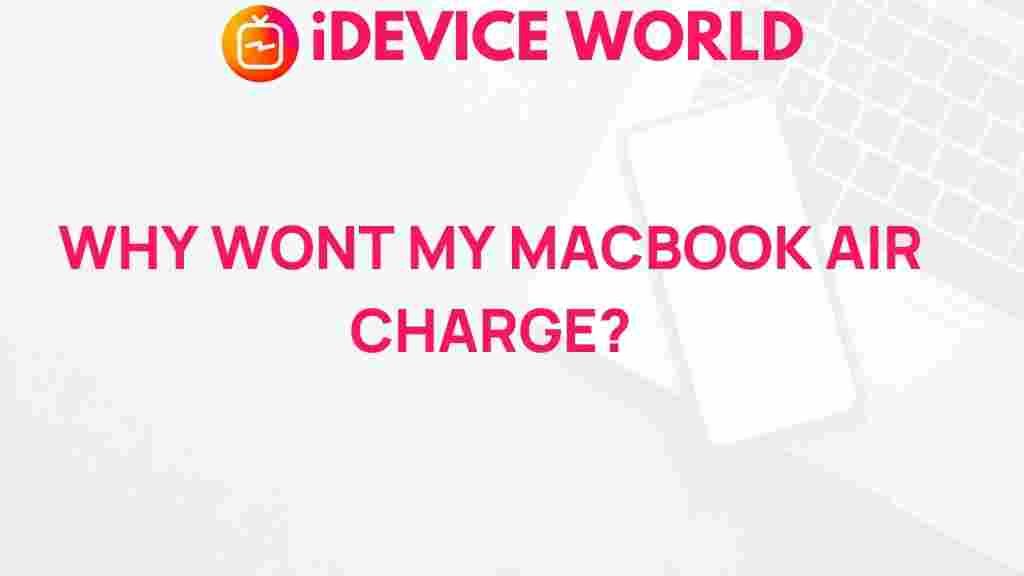Unraveling the Mystery of MacBook Air Charging Woes
The MacBook Air has become a staple for professionals and students alike due to its sleek design and powerful performance. However, many users encounter charging issues that can hinder their productivity. In this article, we will delve into the common problems associated with charging a MacBook Air, explore potential solutions, and provide troubleshooting tips to ensure your device stays powered up and ready to go.
Understanding MacBook Air Charging Mechanisms
Before addressing the specific charging issues, it’s essential to understand how the MacBook Air charging mechanism works. The device relies on a power adapter that converts AC power from the wall outlet into DC power suitable for the laptop. Here are some key components involved in the charging process:
- MagSafe Adapter: The original MacBook Air models used a MagSafe connector, which magnetically attaches to the laptop, ensuring a secure connection.
- USB-C Adapter: Newer models utilize USB-C ports, which allow for charging and data transfer through the same port.
- Battery Management System: This system regulates charging and discharging of the battery to prolong its lifespan.
Common Charging Issues with MacBook Air
Several issues can arise when charging your MacBook Air. Here are the most common problems:
- Device Not Charging: The MacBook Air may show that it is plugged in but does not charge.
- Slow Charging: The device takes an unusually long time to charge.
- Overheating During Charging: The laptop becomes excessively hot while charging.
- Battery Not Recognized: The system may indicate that no battery is installed.
Step-by-Step Process to Diagnose Charging Issues
If you’re facing charging woes with your MacBook Air, follow this step-by-step process to diagnose the issue:
Step 1: Check the Power Adapter
Inspect the power adapter for any signs of damage, such as frayed cables or exposed wires. Ensure that the adapter is plugged into a functioning outlet. If you have access to another compatible adapter, try using it to see if the issue persists.
Step 2: Inspect the Charging Port
Examine the charging port on your MacBook Air for debris or lint. Use a soft brush or compressed air to clean the port gently. A blocked port can prevent a proper connection.
Step 3: Reset the System Management Controller (SMC)
The SMC controls power management features on your MacBook Air. Resetting it can resolve various charging issues. Here’s how:
- Shut down your MacBook Air.
- For MacBook Air models with a removable battery, remove the battery.
- Press and hold the power button for 5 seconds.
- Reconnect the battery (if applicable) and power on your laptop.
Step 4: Check Battery Health
Monitoring your battery’s health can help identify issues. To check battery health:
- Click the Apple logo in the top-left corner.
- Select “About This Mac.”
- Click “System Report.”
- Under “Hardware,” select “Power” and review the battery condition.
If the battery condition shows as “Replace Soon” or “Service Battery,” consider contacting Apple Support for further assistance.
Troubleshooting Tips for MacBook Air Charging Issues
If your MacBook Air continues to experience charging problems after following the diagnostic steps, here are some additional troubleshooting tips:
- Use Original Accessories: Always use the original power adapter and charging cable that came with your MacBook Air. Third-party accessories may not provide the correct voltage.
- Update macOS: Ensure your operating system is up to date, as software updates can fix bugs that may affect charging.
- Run Apple Diagnostics: To run diagnostics, restart your MacBook Air and hold down the “D” key during startup. This will initiate a diagnostic test to check for hardware issues.
- Check for Background Applications: Close unnecessary applications that may be draining battery power while charging.
When to Seek Professional Help
If you’ve tried all the troubleshooting steps and your MacBook Air is still experiencing charging issues, it may be time to seek professional help. Common signs that indicate the need for professional assistance include:
- The device does not power on at all.
- The charging port appears damaged or loose.
- Battery swelling or physical damage is visible.
For repairs, consider visiting an authorized Apple service provider or the Apple Support website for guidance.
Conclusion
Charging issues with your MacBook Air can be frustrating, but understanding the common problems and following a systematic troubleshooting approach can often lead to quick solutions. By ensuring that you are using the right accessories, maintaining your device, and being aware of its health, you can minimize the risk of running into charging woes in the future.
Should problems persist, don’t hesitate to reach out to professionals for help. Keeping your MacBook Air charged and ready is essential for maintaining productivity and enjoying the seamless experience it offers.
This article is in the category Guides & Tutorials and created by iDeciveWorld Team
